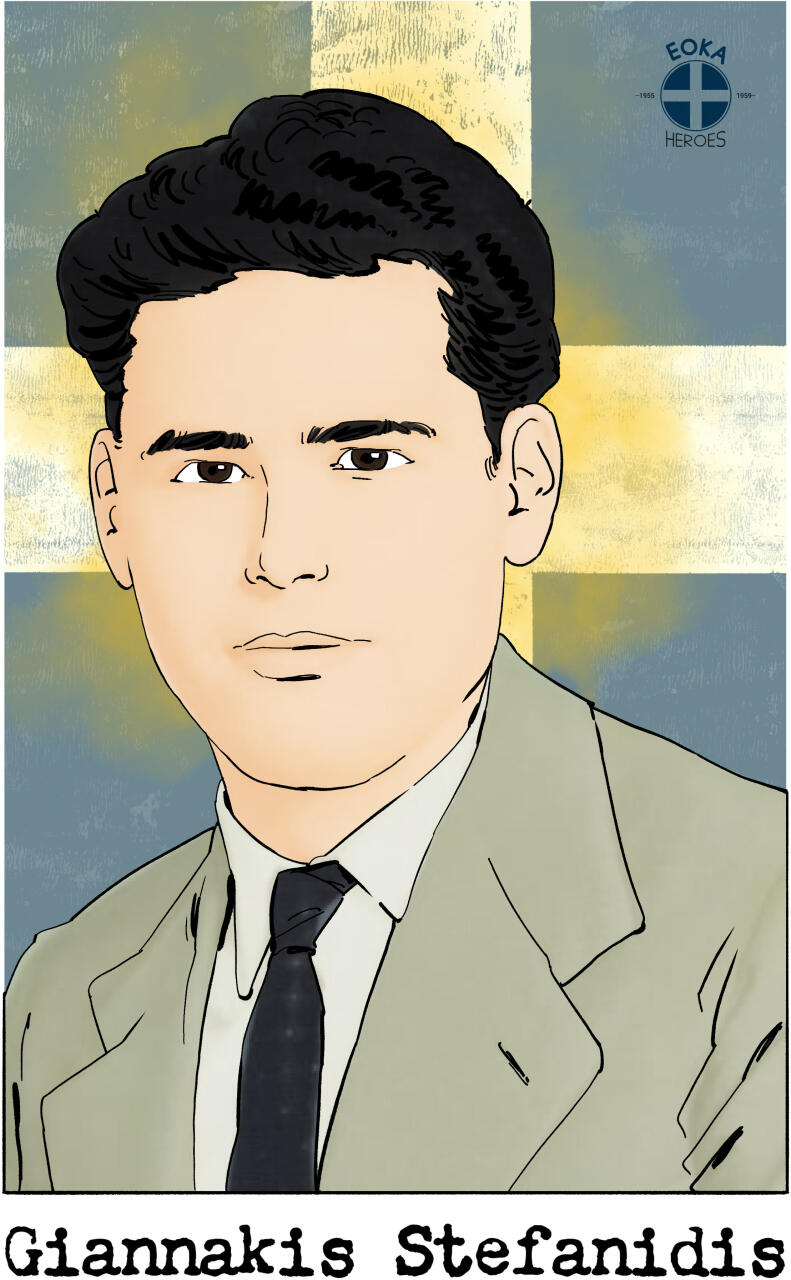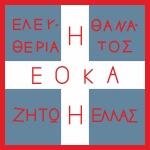Giannakis Stefanidis

Timeline Events
Biography
He was born on June 7, 19391.
He was killed on 10 February 1959 in Aglantzia area2.
His parents are Papa-Andreas Stefanidis, a priest from the village of Patriki in Karpasia, and Eugenia Stefanidis, from Count Kepir3.
He had four siblings, Michalakis, Angeliki, Sotiris and Athanasia. He lived his childhood years, up to the third grade of Primary school, in Komi Kebir He then settled in Nicosia with his family after his father decided to become ordained following in the footsteps of his ancestors.
He graduated from Agios Kasianos Primary School. From a young age he attended Byzantine music lessons. He then attended the Pancypriot Gymnasium4 and the Samuel School. In the national liberation struggle of EOKA 1955-59, he was one of the first to join at the end of 1954, together with the hero fighter Michael Georgallas. They were both initiated into the organization by Father Papastavros Papagathangelou. During the Struggle he acted under the revolutionary names PLINIOS, FAETHON, K.14, AINEIAS, ANDREAS. In his political identity card he used the name Nikos Rossos.
The beginning of the Struggle on April 1, 1955, finds him among the elite members as youth coordinator in the Nicosia province. At the same time, he is trained by the hero Stylianos Lenas, in the use of explosives and the art of blasting.
In mid-January 1956 with the Geri team, he uses his house as a base for the fighters. There, by order of the Leader of the Struggle, Georgios Grivas - Digenis, the organization's armament is gathered.
On August 15, 1956, information was given that the British were going to transfer from the central prisons to the Nicosia General Hospital two of the death row inmates Stelios Mavrommatis, Michael Koutsoftas and Andreas Panagides. EOKA then planned the release of the fighters. Giannakis Stefanidis, then the liaison of the Geri team together with the player Panagiotis Kotzias went to Geri and on August 14 they met Spyros Kyprianou and Polykarpos Giorkatzis again from the Nicosia General Hospital. In the battle that followed, the heroes Ionas Nikolaou and Kyriakos Kolokasis were killed and the fighter Spyros Kyriakou was wounded.
In the summer of 1956, together with Iakovos Pelletier, they placed two mines in a sewer of Tymbou airport from which British military planes would take off. The mines exploded at 2 a.m. and caused serious damage to the airport bus.
In January 1957, the Leader of the Struggle, Georgios Grivas - Digenis, recognizing his abilities and potential, upgraded him by assigning him the responsibility of the Nicosia Sector. A position he maintained until May 1, 1958. In May 1958, together with Sotirakis Giannakis, he undertook the preparation of a defense plan against the vandalism and looting of the Turkish mob in the Greek districts.
In July 1958 he was transferred to Larnaca, with the aim of reorganizing the sector there. In November 1958, Giannakis Stefanidis was ordered to return to Nicosia, allegedly on the orders of Digenis. He himself insists on seeing the Chief's order. An order which, as it turned out, was never issued. Despite the fact that the order was never delivered to him, he nevertheless obeys and moves to Nicosia. His tracks are lost.
On December 6, 1958, the British interrogated a militant of the Organization, mistakenly believing that he was Giannakis Stefanidis. The interrogator, in order to convince him to cooperate with them, and give them information, said to him: "Why don't you cooperate with us, since if you are released, your people will kill you?" Chief Digenis was also informed about this serious incident. How did the British know about the intention of members of the organization to execute Stefanides, who was finally executed? What is the reason for the murder? These questions remain unanswered.
His murder
Based on the "Chronicle 1955-59", written by Georgios Grivas - Digenis, Stefanidis is presented as the last dead of the race. The date of his assassination was February 10, 1959. He was murdered by at least three of his fellow fighters in Aglantzia. His killers, very likely, asked Stefanidis to take part in an operation of the organization to allegedly hide weapons, following an order from the leader Digenis. In the pit opened to place the organization's weapons, they buried Giannakis himself, after one of the killers hit him in the back.
A few months before his brutal murder, three more attempts had been made against him. This time with poison. It is noteworthy that the use of poisons was strictly prohibited by the organization. EOKA fighters have never carried out an operation of the organization using poisons. However, the killers of Stefanides initially chose this way to achieve their plan.
Giannakis Stefanidis, even in the last days of the race, and after three unsuccessful attempts to kill him, had to get out of the way for some very serious reason, according to the testimonies of his fellow competitors. Some spoke of moral lapses, most spoke of jealousy. This is how he had to be assassinated, before the solemn and triumphant descent of the fighters into their towns and villages.
Takis Fotiadis describes how the events developed after the Stefanidis murder in a letter dated April 25, 1961, to Georgios Grivas - Digenis. The house that Giannakis used very often during the match. "...when the struggle ended and Giannakis did not present himself with the other fighters in Ag. Friday his parents were leaning on me, and rightly so, to help them find him. I did what I could and, among others, as you know, 2-3 months after your departure from Cyprus, I visited you at your home in Thisio, where I informed you fully about my actions to find his body and restore his name, since as you stated the Giannakis Stefanidis, "Aeneas" was innocent. Your response was immediate and a week after my return to Cyprus, Mr. Antonis Georgiadis, deputy head of the EOKA, sent me a letter informing me that the body of Giannakis would be given to burial ".
The body of Giannakis Stefanidis, wrapped in a blanket, was abandoned at the Constantine and Eleni cemetery in Nicosia, a few hours before the funeral, on June 26, 1959. During which, a large number of people participated and tragic moments unfolded. The funeral of the tragic hero was held on June 26, 1959. The funeral speech was written by the fighter Renos Lysiotis and due to his fainting, it was delivered by Giannakis Stefanidis' competitor, Phidias Papasavvas. General Georgios Grivas - Digenis in his memoirs makes many references to his actions. It mentions him, as the last dead of the Struggle, who was "murdered in Nicosia on February 10, 1959".
Giannakis Stefanidis is formally restored by the state, after a legal battle and a decision of the Supreme Court, dated June 17, 1970. The newspaper "O Phileleftheros" also makes reference to the above decision, in its publication, the day after the decision, with the title: "Giannakis Stefanidis, was recognized as a fallen fighter of EOKA".
On June 1, 1970, and for the purposes of the trial at the Supreme Court, Antonis Georgiadis, Deputy Leader of the EOKA, filed a signed statement in which he states: "I, the undersigned Mr. Antonis Georgiadis from Nicosia, former Deputy Leader of EOKA, I declare on my own responsibility that Giannakis Stefanidis, formerly from Nicosia, who was the head of EOKA for the province of Nicosia, was, during the Fight, a fighter of the proposed Organization and was not expelled or dropped from this status during this Fight."
On January 3, 1986, the father of Giannakis Stefanidis, father Andreas, who requested a thorough investigation into his son's murder, received a letter of congratulations on the occasion of the new year, from the EOKA 1955-59 Departmental Association. In this letter, he states: "We hope that the new year will bring you joy and happiness and may the All-Good God help to realize our national aspirations for which our beloved competitors, your children, fought and sacrificed." The letter was signed by the then Secretary of the Association Thasos Sofokleous and Elenitsa Serafim-Loizou, President.
Source: https://www.polignosi.com

